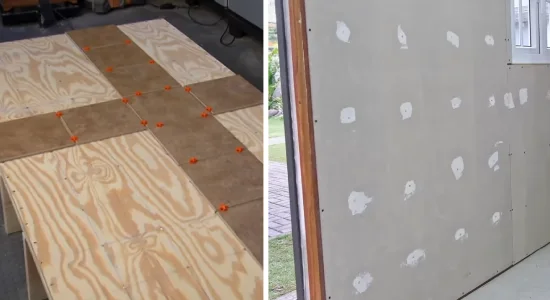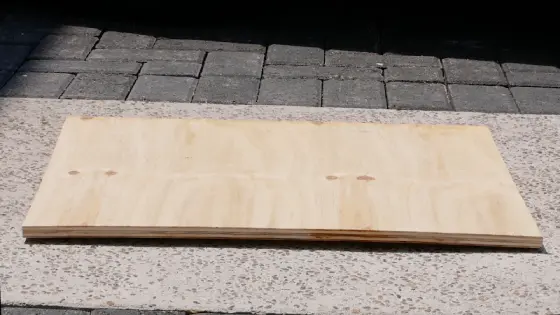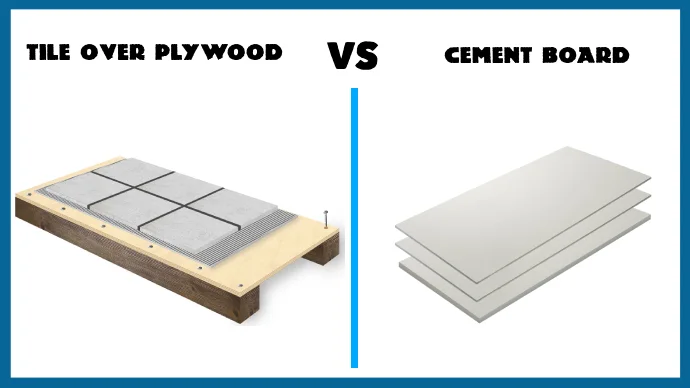Last Updated on September 14, 2023
As you embark on your tiling project, it’s essential to consider the right surface to lay your tiles on. Two popular options are tile over plywood and cement board.
The process of crafting plywood involves layering thin sheets of wood veneer and bonding them together with adhesives. Meanwhile, a cement board consists of sand, cement, and cellulose fibers, forming a rigid panel.
They also differ in moisture resistance, stability, and durability. Let’s get into the discussion of tile on plywood versus cement board. That way, you’ll know which one to choose for your next tiling project.
Differences Between Tile Over Plywood vs Cement Board

If you’re considering tiling over plywood or cement board, there are some important differences to remember.
The material composition of each type can affect its durability, stability, and resistance to moisture. Also, the installation process for each will vary slightly. Let’s take a closer look:
1. Material Composition
Plywood construction consists of gluing together thin sheets of wood veneer using adhesives. The type of wood used for plywood varies, but it is typically constructed from softwood or hardwood. Softwoods like firs and pines are commonly used for manufacturing plywood.
In contrast, a cement board is a rigid panel made of approximately 40-60% cement, 20-30% fillers, 8-10% cellulose, and 10-15% mica. Also, aluminum stearate and PVA are normally used in quantities less than 1%.
2. Moisture Resistance
Moisture can wreak havoc on building materials, causing them to expand, warp, and deteriorate. Plywood is highly susceptible to moisture damage, even though some types are treated with water-resistant coatings. But cement boards are more moisture-resistant.
A cement board’s high resistance to water makes it an excellent choice for areas prone to moisture exposure, like kitchens, bathrooms, and laundry rooms.
When exposed to water for extended periods, the cement board doesn’t expand or deteriorate like plywood. This reduces the risk of tile or grout failure, making it a practical solution for tiling over wet areas.
If you want your flooring to last without succumbing to moisture damage like mold growth or rotting wood, then choose cement board over plywood every time.
3. Stability and Durability
Cement board provides rigidity and stability that plywood simply can’t match. It won’t crack if your subfloor flexes or shifts.
Aside from its durability, the cement board also performs well for a long time. A cement board provides a stable surface that remains intact over time. Unlike plywood, it is not prone to warping or flexing due to changes in temperature or humidity.
This means your tiles will stay securely in place without cracking or shifting, even as the subfloor shifts slightly beneath them.
4. Installation Process
When tiling over plywood, you need to take extra steps to ensure your installation goes smoothly.
To give your tiles the stability they need and prevent any damage to your grout or tiles. So you may need to use a layer of cement backer board or an uncoupling membrane.
The cement board is designed for direct tile installation, making it an excellent base. You can attach tiles or even stone veneer over your cement board. Mesh tape and thin-set mortar reinforce cement board seams.
Do you put cement board over plywood?

Installing cement boards over plywood as a substrate for tile or stone installations is common practice. A cement board is a durable and moisture-resistant material that provides a stable surface for tile installation.
In combination with plywood, a cement board reinforces the substrate and prevents flexing or movement that can crack tiles.
Before installing cement board, you need to ensure that the plywood subfloor is structurally sound, free from any signs of rot or damage, and properly installed.
Typically, you secure the cement board to the plywood using screws or nails. Then, you fill the seams between the boards with thin-set mortar and reinforce them with fiberglass mesh tape.
This combination of plywood and cement board creates a solid and stable base for tile installations, ensuring long-lasting and reliable results.
How thick should plywood be under the tile?
If you want a sturdy and reliable base for your new tile flooring, go for the recommended thickness of 3/4 inch plywood. This thickness provides ample support to hold the weight of the tiles and withstands daily foot traffic and other loads.
Plywood that’s thinner than this may not offer sufficient strength and could cause tiles to crack or loosen over time. You need to note that while cement board can be used as an alternative to plywood, it doesn’t necessarily provide better results.
In fact, using cement boards without a proper subfloor can still result in cracking or loosening of tiles. Therefore, you need to use a thick enough subfloor material like 3/4 inch plywood under the tile to ensure long-lasting stability and durability for your flooring.
Does plywood warp with heat?
Plywood can indeed warp when exposed to heat. The main cause of warping in plywood is the fluctuation of moisture levels within the wood.
When exposed to high temperatures, the moisture content within the plywood can evaporate rapidly, leading to shrinkage.
As the plywood shrinks unevenly across its surface, warping occurs. This warping can result in significant deformations and negatively impact the structural integrity of the plywood.
To mitigate the effects of heat-induced warping, certain measures can be taken. Storing plywood in a room with a relatively stable temperature, around 35 degrees Celsius, can help reduce the frequency and severity of warping.
What type of plywood does not warp?

There’s no plywood type that’s completely warp-proof. But, certain factors can contribute to a plywood’s resistance to warping.
In general, plywood with a stable and balanced construction is less likely to warp. Multiple layers of hardwood veneers are bonded together to make veneer core hardwood plywood, which is often praised for its structural strength and stability.
The use of high-quality hardwood veneers and precise manufacturing techniques can help reduce the risk of warping.
Also, plywood that has been properly sealed with a water-resistant sealant can provide an added layer of protection against moisture, a common cause of warping.
Selecting the Optimal Substrate for Your Tile: Cement Board vs. Plywood
Choosing the right substrate for your tile installation ensures long-term performance and integrity. Plywood may be budget-friendly but is less stable or moisture-resistant than cement board.
Cement board is the superior choice for areas with water exposure, movement, and subfloor imperfections, such as bathrooms, kitchens, and laundry rooms.
But plywood can be an acceptable substitute if your subfloor is level, dry, and stable. Always follow the manufacturer’s installation guidelines and specifications to ensure successful tile installation.



